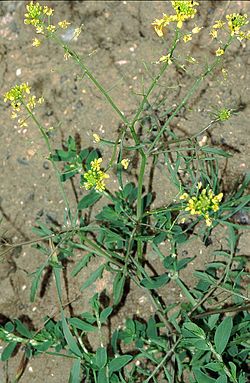| Rorippa sylvestris | |
|---|---|
 | |
| Scientific classification | |
| Kingdom: | Plantae |
| Clade: | Tracheophytes |
| Clade: | Angiosperms |
| Clade: | Eudicots |
| Clade: | Rosids |
| Order: | Brassicales |
| Family: | Brassicaceae |
| Genus: | Rorippa |
| Species: | R. sylvestris |
| Binomial name | |
| Rorippa sylvestris | |
Rorippa sylvestris (the creeping yellowcress, [1] keek, or yellow fieldcress; syn. Radicula sylvestris (L.) Druce [2] ) is an invasive species [3] of plant in the United States, likely entering from Europe before 1818 from ballast water and spreading throughout North America through contaminated nursery seed stock. [4]